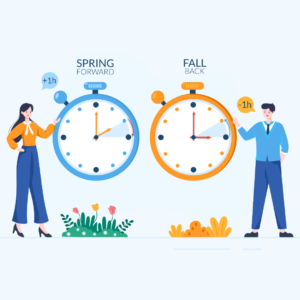
Daylight Saving Time (DST) is a practice of moving the clocks forward by one hour during the warmer months of the year, typically in spring, and moving them back again in the fall. This adjustment aims to make better use of daylight during the longer days of summer, allowing people to enjoy more daylight hours in the evening.
Purpose of Daylight Saving Time
The primary purpose of DST is to maximize the use of natural daylight in the evenings, which can lead to various benefits. By aligning our waking hours with sunlight, it helps reduce energy consumption, as less artificial lighting is needed. This, in turn, has been seen as a way to conserve resources, especially during times of crisis or high energy demand. DST is also thought to encourage outdoor activities, boost retail sales, and enhance road safety with more daylight in the evening hours.
History of Daylight Saving Time
The idea of shifting the clock to better align with sunlight dates back to 1784, when it was first suggested, somewhat humorously, by American statesman Benjamin Franklin in a letter to the editor of the Journal de Paris. Franklin’s suggestion was not taken seriously at the time, but the concept resurfaced more earnestly in the early 20th century.
Modern DST was first proposed by British builder William Willett in 1907, who campaigned to shift clocks to extend daylight hours for leisure activities. Germany became the first country to implement DST on a national scale during World War I in 1916 to save energy for the war effort. Other countries, including the United States and the United Kingdom, soon followed suit. The practice saw a resurgence during World War II and during subsequent energy crises, emphasizing resource conservation.
Countries Following Daylight Saving Time
Today, the use of DST varies worldwide. More than 70 countries observe DST, primarily in Europe, North America, and parts of the Middle East. In Europe, all member states of the European Union adjust their clocks in unison, while in the United States, most states observe DST except for Hawaii and most of Arizona. Many countries in Africa and Asia do not use DST, and several have abolished the practice over the years due to limited effectiveness in their geographic regions.
Countries such as Australia and New Zealand, which have longer summer daylight hours due to their position relative to the equator, also observe DST in certain regions. However, many tropical regions near the equator have opted out since their daylight hours remain relatively consistent throughout the year.
Criticisms and Continued Debate
DST has its share of critics. Some argue that the disruption to our internal clocks can lead to sleep disturbances, decreased productivity, and even health issues during the transition periods. Farmers, in particular, have expressed concerns about its impact on their schedules and livestock. Despite this, many countries continue to observe DST, while others have chosen to abolish it altogether, citing its diminishing returns in a modern, electrified world.
Impact of DST on Scheduling Adar Learning Students Classes
Daylight Saving Time (DST) significantly impacts our students’ scheduling, particularly in matching availability between teachers and students across different time zones. As clocks shift, ensuring that class timings are aligned correctly becomes challenging, often requiring adjustments to avoid conflicts and maintaining consistency in learning schedules. This is complex when teachers and students are located in regions (countries) with differing DST observance policies. However, our team is vigilant in updating schedules and communicating changes clearly, in advance to minimize disruptions and ensure smooth, effective class delivery at changed timings.
Conclusion
Ultimately, the impact of DST varies depending on geography, lifestyle, and individual perspectives. As debates about its usefulness continue, what remains clear is that the practice reflects society’s ongoing efforts to adapt our routines to the natural rhythms of daylight. Whether you love it or dread it, DST is a reminder of how timekeeping shapes our daily lives and reflects humanity’s continuous effort to make the most of our time under the sun.
